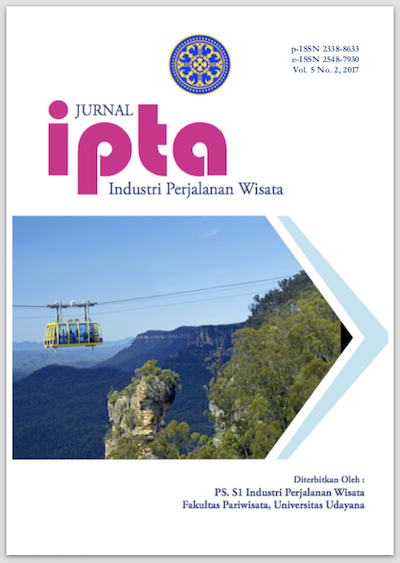ARAHAN PRODUK PARIWISATA BERBASIS MASYARAKAT LOKAL DI WILAYAH PERDESAAN
Abstract
This paper addressed the process of the development of community-based rural tourism products in Pinge Tourism Village. Community-based rural tourism products are acknowledged as a tourist attraction in rural areas created by local communities be based on the tourism resources that possess by communities themselves. Pinge Tourism Village has a various of tourism resources that can be developed as a local community-based rural tourism product. From the inside of the physical environment resources to the diversity of social and cultural heritage. In adaptation with the mapping of tourism resources, can be determined the themes of development of community-based rural tourism products. There are four themes that can be considered for the development of community-based rural tourism products in Pinge Tourism Village, specifically spiritual routine, agricultural routine, gastro-cultural routine, and communal routine. These four themes further form the basis for determining community-based rural tourism products or special interest tourism activities of traditional villages in Pinge Tourism Village. There are several guidelines for the development of community-based rural tourism products that can be developed in Pinge Tourism Village such as spiritual tourism, agritourism, culinary tourism, and rural nightlife attraction.
Downloads
References
Boniface, B., Cooper, C., and Cooper, R. 2012. Worldwide Destinations; the geography of travel and tourism. London: Routledge.
Bramwell, B. 2010. Participative Planning and Governance for Sustainable Tourism. Tourism Recreation Research. 35: 239-249.
Briedenhann, J. and Wickens, E. 2004. Rural Tourism-Meeting the Challenges of the New South Africa. International Journal of Tourism Research. 6: 189-203.
Butler, Richard W. 1980. The concept of a tourist area cycle of evolution: implications for management of resources. The Canadian Geographer/Le Géographe canadien. 24: 5-12.
Byrd, Erick T., Bosley, Holly E., and Dronberger, Meghan G. 2009. Comparisons of stakeholder perceptions of tourism impacts in rural eastern North Carolina. Tourism Management. 30: 693-703.
Carson, D. A., Carson, D. B., and Hodge, H. 2014. Understanding local innovation systems in peripheral tourism destinations. Tourism Geographies. 16: 457-473.
Daldeniz, B. and Hampton, Mark P. 2013. Dive Tourism and Local Communities: Active Participation or Subject to Impacts? Case Studies from Malaysia. International Journal of Tourism Research. 15: 507-520.
Feighery, William G. 2008. “Heritage Tourism in Xi’an: Constructing the Past in Contested Space”. Dalam Janet Cochrane (ed). Asian Tourism: Growth and Change. UK: Elsevier.
George, E. Wanda, Mair, H., and Reid, Donald G. 2009. Rural Tourism Development: Localism and Cultural Change. UK: Channel View Publications.
Idziak, W., Majewski, J., and Zmyślony, P. 2015. Community participation in sustainable rural tourism experience creation: a long-term appraisal and lessons from a thematic villages project in Poland. Journal of Sustainable Tourism. 23:1341-1362.
Inskeep, E. 1991. Tourism Planning; An Integrated and Sustainable Development Approach. Canada: John Wiley & Sons.
Lane, B. 1994. What is rural tourism?. Journal of Sustainable Tourism. 2: 7-21
Page, S. J. & Getz, D. (Eds.), 1997, The business of rural tourism: international perspectives. London: International Thomson Business Press.
Reid, D. G., George, E. W., and Mair, H. 2009. Rural Tourism Development; Localism and Cultural Change. UK: Channel View Publications.
Roberts, Lesley and Hall, Derek. 2001. Rural Tourism and Recreation; Principles to Practice, UK: CABI Publishing.
Roberts, L. and Hall, D. 2004. Consuming the countryside: Marketing for rural tourism. Journal of Vacating Marketing. 10: 253-263.
Romeiro, P., and Costa, C. 2010 The potential of management networks in the innovation and competitiveness of rural tourism: a case study on the Valle del Jerte (Spain). Current Issues in Tourism. 13: 75-91.
Smith, S. L. J. 1994. The Tourism Product. Annals of Tourism Research. 21: 582-595.
Tosun, Cevat. 2006. Expected nature of community participation in tourism development. Tourism Management. 27: 493-504.
WTO. 1998. Guide for Local Authorities on Developing Sustainable Tourism. World Tourism Organization.
Zou, T., Huang, S., and Ding, P. 2014. Toward A Community-driven Development Model of Rural Tourism: The Chinese Experience. International Journal of Tourism Research. 16: 261-271.

This work is licensed under a Creative Commons Attribution-ShareAlike 4.0 International License.





